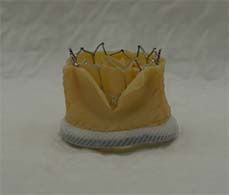
Insufficient blood flow towards the coronary vasculature following transcatheter aortic valve implantation (TAVI) is a dreadful complication. This can result in a wide spectrum of clinical manifestations ranging from simple angina months after TAVI to full circulatory collapse immediately after valve deployment. Approximately half of the patients that encounter this complication die shortly after TAVI. In this commentary, Danny Dvir outlines how a new approach—bioprosthetic or native aortic scallop intentional laceration to prevent iatrogenic coronary artery obstruction (BASILICA)—could help to prevent coronary obstruction after TAVI.
Fortunately, coronary obstruction is rare, affecting <1% of native valve TAVI population and 2–3% of those performed in failed bioprosthetic valves (valve-in-valve). However, given the consequences of the complication, we must recognise patients at risk and do the best we can to prevent it. In recent years, we advanced our ability to accurately identify patients at risk. A computed tomography (CT)-derived parameter—named “VTC” (virtual transcatheter heart valve to coronary distance)—seems to be a powerful tool. A VIVID registry analysis shows that a short VTC distance predicts coronary obstruction.1 An optimal cut-off of 4mm identifies patients at risk for the complication with high both sensitivity and specificity. Previously, patients at risk for coronary obstruction were referred for high-risk redo surgery or treated medically with poor prognosis. Some of them were referred for TAVI and needed techniques to prevent coronary obstruction. For example, using “chimney stenting”, TAVI is performed while an un-deployed stent is positioned in the coronary tree to be pulled back and deployed in the coronary inflow if there is an obstruction or retrieved if there is normal coronary flow. Bailout coronary stenting is feasible in most patients; however, longer-term outcomes of this technique are suboptimal, with potential concerns including stent jailing while attempting to retrieve it, thrombosis, restenosis, and it is near-impossible re-access to the coronary vasculature.
New approaches
In recent years, several novel techniques to prevent coronary obstruction were designed. It seems that the optimal method to prevent sinus inflow obstruction should act directly on the origin of the obstruction, the failed valve cusp, that when deflected causes coronary obstruction. An intentional laceration of the failing surgical bioprosthetic leaflet to maintain access to the coronary ostia has been proposed. The concept of BASILICA is that the sliced leaflet splays after valve deployment and creates a triangular space that allows blood flow towards the sinus and from it to the coronary artery, which otherwise can be occluded (Figure 1).

BASILICA uses electrosurgery techniques previously employed in other transcatheter procedures. It includes traversing the leaflet with an electrified wire, to be snared in the left ventricle outflow tract. Later, that wire is delivered to the leaflet after being kinked and selectively denuded. The wire is re-electrified and pulled from both sides, causing an effective leaflet laceration. Subsequently, TAVI is performed and the deflected lacerated leaflet splays into two parts and enables blood flow through the created leaflet gap. Accurate traversal and laceration are guided by fluoroscopy and occasionally by transoesophageal echocardiography.2,3 First-in-human BASILICA procedures were performed in July 2017 in University of Washington (Seattle, USA) and they were performed in more than 100 cases in US and Europe in the following 18 months. Preliminary data from a meticulously performed US NIH sponsored study of 30 patients were recently presented, showing high efficacy and safety of the technique.
The dramatic worldwide growth of TAVI procedures, including device designs that can be prone for coronary obstruction if require a valve-in-valve, suggests that BASILICA will be more commonly required in the future. Emerging innovations may provide dedicated tools that will further disseminate the technique. A modification of the BASILICA technique may be applied to extremely calcified leaflet conditions to enable better TAVI expansion for optimal valve performance and device durability. This modification is especially appealing for bicuspid aortic valves and may enable successful “tricuspidisation”. This will further improve our ability to treat younger lower-risk population with TAVI. In the meantime, physicians caring for patients at risk for coronary obstruction should not attempt BASILICA without careful proctorship by an experienced operator since the technique and lack of efficacy can casue a life-threatening complication.
References
- Ribeiro et al. Eur Heart J 2018; 39(8): 687–95.
- Khan J et al. JACC Cardiovasc Interv 2018; 11(7): 677–89.
- Dvir D et al. EuroIntervention 2018; 14 (AB):AB74–82.
Danny Dvir is at Interventional cardiologist, University of Washington Medical Center, Seattle USA. He spoke about this topic at the European Association European Association for Cardio-Thoracic Surgery (EACTS) annual meeting (18–20 October, Milan, Italy).












